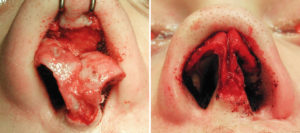
In the December 2017 issue of the Aesthetic Surgery Journal an article was published entitled ‘Asian Cleft Rhinoplasty: The Open Structural Approach.’ In this paper the authors present their experience using an open structural technique for Asian cleft rhinoplasty using rib cartilage and temporalis fascia. The basic tenets of their approach include a central septocolumellar graft combined with extender spreader grafts (from rib) to lengthen the tip of the nose. The dislocated lower alar cartilage on the cleft side was then completely detached and mobilized off the vestibular lining. The deficient medial crura was lengthened with the lateral crural steal procedure. The resultant shortened lateral crura was reconstructed with the lateral crural strut graft. Tip suturing and cartilage grafting was done. Dorsal augmentation was accomplished using diced cartilage wrapped in temporal fascia. At closure, a reverse-U excision of the vestibular lining was performed to correct the alar hooding on the cleft side. Alar base reductions were done as needed and the depressed alar base augmented with a small rib graft.
Over a five year period, thirty-fee (35) Asian parents underwent open cleft rhinoplasty. (18 females, 17 males and 23 unilateral clefts and six bilateral clefts) There were 18 female patients and 17 male patients. Twenty-nine patients were unilateral clefts and 6 were bilateral clefts. All patients were highly satisfied with the functional and aesthetic improvements of their nose. The complications ( infection) and revision rates (2 patients) were low.
This paper documents the use of the open rhinoplasty approach using all autologous materials. (rib and temporal fascia) It avoids the use of any synthetic materials which are commonly used in many aesthetic Asian rhinoplasties. The key to the technique is the septocolumella graft in the midline which saves as the central tentpole of support onto which tip projection and nasal length can then be set.
Dr. Barry Eppley
Indianapolis, Indiana


